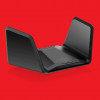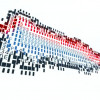How the Mars Rovers Phone Home
How do you get giant amounts of data from a spacecraft sitting on the surface of Mars? For NASA's Spirit and Opportunity rovers, the indirect way is the best way -- using relay satellites that orbit Mars.
Each rover has a high-gain microwave antenna that can transmit scientific data directly to Earth, but more often than not uses a low-gain UHF antenna to transmit the data to either Mars Odyssey or Mars Global Surveyor, spacecraft in orbit above Mars.
"This transfer of data is much more efficient because the orbiters have much bigger solar arrays and bigger antennas, so they're not so much energy- and bandwidth-constrained as the rovers are," Jet Propulsion Laboratory telecom engineer Andrea Barbieri said. Think of it as a low-power cell phone talking to a nearby transmitter tower, which has far more power. Using spacecraft in orbit, the relays can transmit data 10 times faster than the direct link.
For the 1976 Viking mission, NASA used brute force -- a 20-watt transmitter with a nuclear power source. The current Mars missions have to be much smaller and less expensive. So they use low-power transmitters and rely on solar power. But they have the advantage of three decades of improvements in electronics, both on the spacecraft and on the ground.









































































